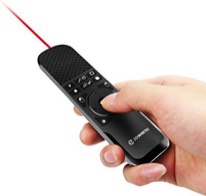Home
A comprehensive resource for safe and responsible laser use
Why laser pointers may not be best for presentations
The two most common uses of low-powered handheld lasers are probably for playing with pets, and for pointing at PowerPoint-type slides during presentations to an audience.
For presentations, the laser's relatively bright dot gets attention (the same as with pets!). Because of this advantage, there are a number of presentation remote controls that advance the slides and include a laser pointer as well:
For presentations, the laser's relatively bright dot gets attention (the same as with pets!). Because of this advantage, there are a number of presentation remote controls that advance the slides and include a laser pointer as well:

But at least one author feels that there are some disadvantages to using laser pointers in presentations.
In a February 23 2020 blog post entitled "Rethinking Laser Pointers," Carolyn Trietsch noted the following:
Trietsch did write that laser pointers are good for impromptu moments, such as when answering a question from the audience and you need to highlight something that you didn't plan for.
In her final guidance, she cautioned "… of course, never, ever point a laser at your audience members. You want to blind them with your brilliance, not with a poorly used laser pointer."
One blog commenter added another potential problem with pointers: "I was warned not to use a laser pointer unless you had a very steady hand. Apparently at my school there had been a few unfortunate incidents where indiscriminate laser pointer use had actually triggered motion sickness."
Thank you to Greg Makhov for bringing this blog post to our attention.
In a February 23 2020 blog post entitled "Rethinking Laser Pointers," Carolyn Trietsch noted the following:
- The laser dot can be distracting, taking attention away from the points you are making
- For colorblind persons, the dot can be fainter or otherwise harder to see
- If you are nervous, the dot can shake which gives away your nervousness
- For word slides, the laser should not be aimed at bullet points, or track each word of the text as you read it
- For graphics and visual slides, the presentation software has built-in animations that can be added, such as an arrow that appears or a circle to highlight part of an image.
Trietsch did write that laser pointers are good for impromptu moments, such as when answering a question from the audience and you need to highlight something that you didn't plan for.
In her final guidance, she cautioned "… of course, never, ever point a laser at your audience members. You want to blind them with your brilliance, not with a poorly used laser pointer."
One blog commenter added another potential problem with pointers: "I was warned not to use a laser pointer unless you had a very steady hand. Apparently at my school there had been a few unfortunate incidents where indiscriminate laser pointer use had actually triggered motion sickness."
Thank you to Greg Makhov for bringing this blog post to our attention.
